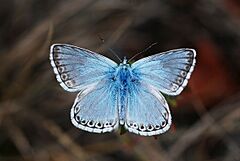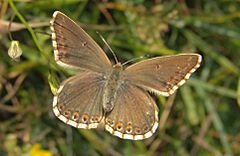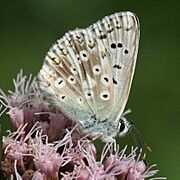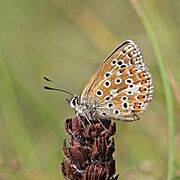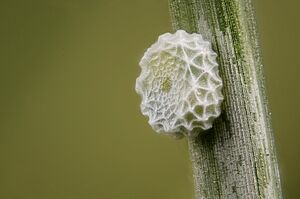Chalkhill blue facts for kids
Quick facts for kids Lysandra coridon |
|
|---|---|
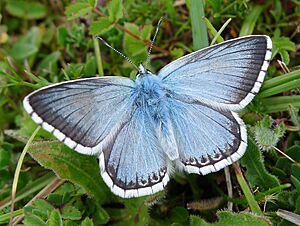 |
|
| Male L. coridon | |
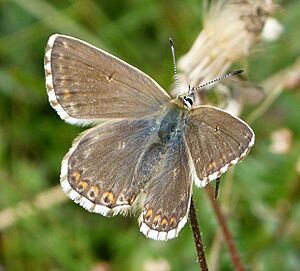 |
|
| Female L. coridon | |
| Scientific classification | |
| Synonyms | |
|
The chalkhill blue (Lysandra coridon) is a beautiful butterfly. It belongs to the family Lycaenidae, also known as the "blues" or "coppers." This small butterfly lives across a large area called the Palearctic realm. You can mostly find it in grasslands that have lots of chalk in the soil.
Male chalkhill blues are a pretty pale blue color. Females are brown. Both have cool patterns around the edges of their wings, like a checkerboard.
Contents
What Does the Chalkhill Blue Look Like?
The chalkhill blue butterfly has a wingspan of about 30 to 36 millimeters (that's about 1.2 to 1.4 inches). Boys and girls of this butterfly look different, which is called sexual dimorphism.
Males have shiny, pale silvery-blue upper wings. They have a line of grey spots near the edge of their back wings. The very edge of their wings has a thin brown and white checkerboard pattern.
Females have dark brown upper wings. They have orange spots near the edges and also the same checkerboard pattern.
If you look at the underside of their wings, they are a light yellowish-brown color. You'll see several dark spots with white rings around them. There's also a line of black marks and a row of orange spots on the back wings. Near their body, the underside has a dusting of blue.
It can be tricky to tell chalkhill blues apart from other blue butterflies. The patterns on the underside of their wings are usually the best way to identify them. Sometimes, you might even see butterflies with unusual color patterns!
Where Do Chalkhill Blues Live?
Geographical Range
You can find the chalkhill blue butterfly in many parts of the Palearctic realm. This includes western, southern, and central Europe, as well as parts of Asia Minor, the southern Urals, and northwest Turan.
This butterfly is very common across Central Europe. However, it's not found everywhere. For example, you won't see it in Ireland, Scotland, or Scandinavia. It's also mostly absent from the Iberian Peninsula (Spain and Portugal), except for some northern areas. Some Mediterranean islands don't have them, but they are found in Corsica and Sardinia. Most of southern Italy also doesn't have them.
Habitat
Chalkhill blues love dry calcareous grasslands. These are grasslands with soil rich in chalk or limestone. They prefer to live at heights between 100 and 2,000 meters (about 330 to 6,560 feet) above sea level.
They especially like grasslands with short grass and lots of flowering plants. Chalkhill blues don't travel very far. They tend to stay in their home patch of habitat. They usually don't fly long distances to find new places to live.
Life Cycle and Habits
The chalkhill blue butterfly usually has only one generation each year. This means they breed once a year and produce one set of offspring. This is called being univoltine.
The caterpillars of this butterfly are quite picky eaters! They only feed on one specific plant species. This is called being monophagous. Their favorite food is the leaves of the horseshoe vetch plant.
When the caterpillars are ready, they turn into a pupa (like a chrysalis). They do this on the ground, often hidden among the dead leaves of their food plants.
Interestingly, different types of ants often look after the chalkhill blue caterpillars. These ants belong to groups like Myrmica, Lasius, and Formica. The caterpillars have a special gland that produces a sweet liquid. The ants drink this liquid and, in return, they protect the caterpillars from predators.
You can usually see adult chalkhill blue butterflies flying around from June to October.
Conservation Status
Status
The chalkhill blue butterfly is currently listed as a species of "Least Concern" by the IUCN Red List for Threatened Species. This is good news! It means their population hasn't dropped by a lot (less than 25%) in the last ten years.
Conservation Efforts
Because they are not highly threatened, there aren't many special conservation plans just for them. However, in some areas where their numbers have declined, people have started conservation efforts.
Scientists consider the chalkhill blue a good "indicator species." This means that if the chalkhill blue is doing well, it's a sign that the calcareous grassland habitat is healthy. Studying this butterfly can also help scientists create conservation programs for other, more endangered species.
Conservation in the United Kingdom, Germany, and Poland
Many countries, like the United Kingdom, Germany, and Poland, have studied how to protect calcareous grasslands. Protecting the chalkhill blue helps protect many other animals that live in these important ecosystems.
United Kingdom
The chalkhill blue population in the UK dropped a lot in the 1950s. But then, from 1981 to 2000, their numbers started to grow again! By the 1990s, the population became stable. This improvement happened because of good conservation practices. These included controlling how much animals grazed, setting up protected areas, and using special farming programs that helped the environment. All these actions made the butterfly's habitats much better.
Germany and Poland
Both Germany and Poland have plans for protecting these butterflies. They believe the best way to help is to protect large areas of grassland that are connected to other fragmented grassland habitats. These areas should also have lots of the horseshoe vetch plant, which is what the young caterpillars eat.
See also
Images for kids


